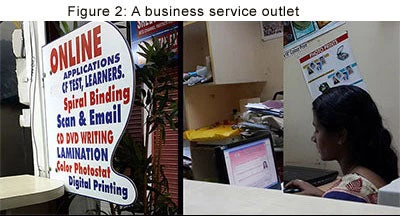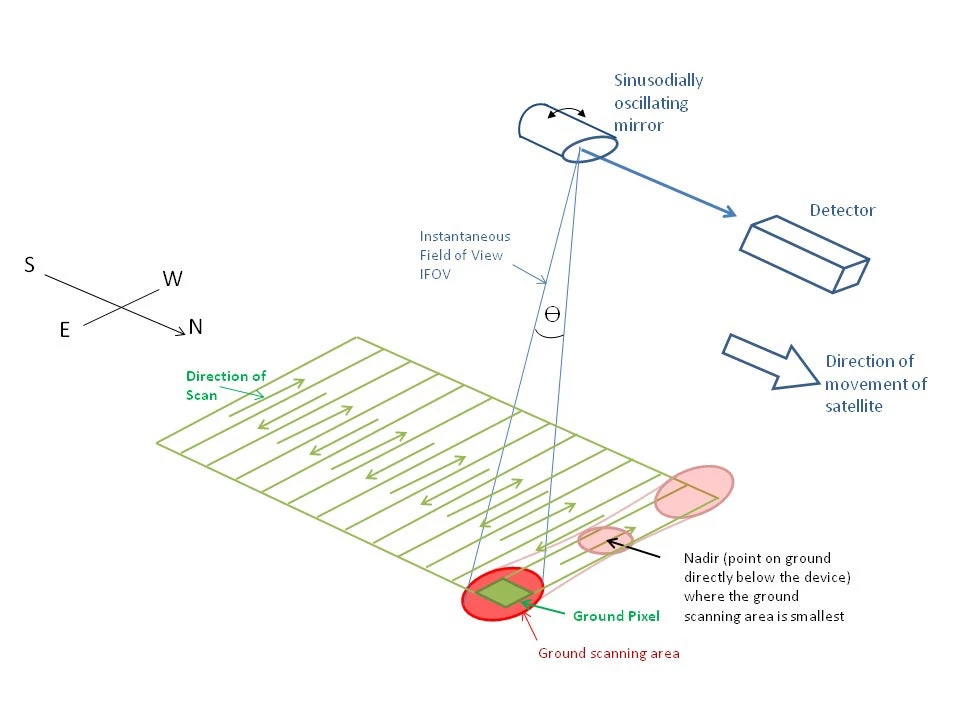I was intrigued by Kerala's Akshaya program. Kerala is uniquely, a most decentralized state, the only one of 17 in India to enact the Right to Public Services and, to open citizen service centers called Akshaya, run under the oversight of panchayats, 3-tier local self-governments, in 14 districts set within a 2 km radius of households. Akshaya was designed in its first phase in 2003 by the Kerala IT Mission to improve e-literacy in underserved areas and, in its second phase to provide a platform for government to citizen services through a public-private partnership. Over 60% of Kerala's 33 million citizens have been served by 2070+ Akshaya centers run by private entrepreneurs who collectively earn 30 million INR a month, creating employment for over 20,000 individuals. (For more details, see Akshaya Overview and UNDP Report on Akshaya).
Kerala's e-Governance programs, including Akshaya, are set within the context of a US$ 9 billion National e-Governance Program (NeGP), at the heart of the Government of India's strategy to improve services at the base of the delivery chain. The goal of the government-wide NeGP initiative is to make services accessible to 'the common man' in her/his locality. It seeks to increase the reach of government both geographically and across income classes. The initiative focuses on efficiency, equity and transparency of services by reducing the burden of physical visits to separate agencies, providing ready access to information, diminishing the discretion of officials, curtailing leakages and corruption in services delivery. State IT Mission teams and a Central NeGP team provide the capacity to implement NeGP across India.
In February, I had a chance to experience Kerala's e-Governance program first-hand when it was time to renew a driver's license. To understand and evaluate the process from the perspective of an ordinary citizen seeking a service, I used a design evaluation technique, a ïcitizen walkthrough' employed to improve the interaction between the government and citizen. (See journal article on designing e-government services, L. van Velsen et al., Government Information Quarterly, 2009.) On a related note, some readers may recall that this blog series highlighted in January 2014 how the US Government uses user-centered design thinking to improve the quality of digital public services.
Citizen Walkthrough of an e-Governance Service in Kerala
Sitting in Washington DC, a google search 'renew driver's license Kerala' brought me to the Motor Vehicles Department (MVD) website, and a link to apply. The website provides a set of instructions which organize the process in four parts. The first part is online; the citizen applies for a case number, although I could not register from the United States. The second part is offline; the citizen prints and fills out a set of forms (an application form to renew a license + a certificate of visual standards for driving + a medical certificate) and furnishes supporting documents (attested proof of address and date of birth). The third part is online; the citizen makes an e-payment. The fourth part is offline; the citizen submits the application number, forms, supporting documents and proof of payment to the Road Transport Office (RTO). (See Figure 1)
On a trip to Kerala in February, I paid a visit to the Trivandrum RTO. People jostled for space at the Public Relations Officer's counter. Being one among few women in a relatively tight space, it was a somewhat disconcerting start. I managed to get to the front of the counter to ask the officer how one might renew a driver's license. He pointed me to a poster off to the side, written in Malayalam and English.
- Part 1 - Online - She entered my driver's license number on the Kerala MVD website and registered an application case number. It took 5 minutes.
- Part 2 - Offline - Next, she printed application forms, which I filled in. For a vision certificate, we went to an optician located in the shopping complex. I produced a recent doctor's prescription for the certificate. Then we took a copy of my passport and had a gazetted officer verify against the original. It took roughly 90 minutes.
- Part 3 - Online - For e-payment, we took a rickshaw to an Akshaya citizen service center, about 5 minutes away. We took a token and waited until our turn. There were 18 other people waiting patiently in chairs - mostly women, a few men. There were two young women in front of a computer. Under a benevolent portrait of the father of the nation, they explained government process steps to citizens with confidence, clarity and authority. Citizens came to get help with government services, such as paying utility bills, getting identity cards etc. When it was my turn, they handled the cash, entered payment details online and issued a receipt, all quite efficiently. It took roughly 45 minutes including wait time (See Figure 3).
- Part 4 - Offline - We went back to the RTO to submit all required documents. The RTO offered to issue the license that afternoon at 4 pm (through a fast track process), but I had to travel, so they mailed it via speed-post in 4 days (2 of which were lost due to a postal strike).
 I paid the agent 50% of the value of the transaction to receive guidance on where to go and how to complete the transaction. The entire process took a little over 3 hours.
I paid the agent 50% of the value of the transaction to receive guidance on where to go and how to complete the transaction. The entire process took a little over 3 hours.
Game-Changers - Right to Services, Local Citizen Centers and the Internet
- Transparency - There have been massive improvements in transparency and accountability for delivering citizen services in Kerala. 20 years ago when I first applied for a license, it was hard to discern what were the processes and supporting documents for the transaction, to get access to relevant forms or to interface with the appropriate officials during office hours. Today, this information is visible and accessible online.
- Accountability -An application case number facilitates tracking and monitoring service requests. Citizens stand to gain from the right to service and improvements in turnaround time.
- Governance & Anti-corruption - The e-payment system provides a framework to streamline cash handling and corruption. However the persistence of unlicensed agents in the system suggests the risk of fraud and petty corruption endures. See seminal paper on agents as channels for corruption in driver's licenses in India, Bertrand, Djankov et al., 2006.
- Digital Inclusion - Some argue that e-governance programs are not for the masses. They are less likely to have access and can ill-afford the internet via personal computer or mobile devices. A quick visit to an Akshaya in Kerala presses home the importance of targeting service delivery centers closer to citizens. They suffer most from poor quality service delivery -time spent at far-away government offices, chasing up forms and supporting documents, rent-seekers or circling back to follow-up. According to an anecdote by the Kerala State IT Mission, agricultural laborers in hilly hard-to-reach areas cannot afford to miss a day of work. They submit documents to a local Akshaya at 8 am and pick up either in the evening after the day's labor or upon receiving an SMS, that the certificate is ready.
What can we take away from the Kerala e-Governance service delivery model that could be applicable to other contexts?
- Citizen-centered design -Combining online and offline tasks can make the end-to-end process cumbersome for citizens. To redesign government processes to become more citizen-centered and to improve performance management, design evaluation methods, e.g., citizen walkthroughs (from a sample set of users), provides an evidence-basis for change (See Verschuren & Hartog, 2005; Hevner et al, 2004). The citizen's journey should be mapped end-to-end, i.e. along the whole process and not only once an application is submitted online, to gauge the rate of rejection of applications and the intricacy of back office decision making processes. Walkthroughs can also reveal where bureaucratic hurdles are greater (such as caste certificates) and fewer (such as driver's licenses).
- Agents and/or Self-Service - Ordinary citizens may not be familiar or comfortable with government services they use infrequently. Even the most sophisticated users may admit faltering at self-service check-in kiosks for airlines and check-out counters at the supermarket, or even standing in line for movie tickets instead of using an available vending machine. It's likely that an informal market will spring up to supply guidance for a percentage of the transaction or worse, become channels for corruption. For a small fee, citizen service centers could provide a trusted space for licensed agents in the community to help citizens with information on the process and walkthrough. Through their experience guiding citizens, licensed agents could prove a valuable source of insight for evaluating and improving services.
- Use the Internet to Decentralize - That information can be decentralized by means of the internet, and thereby potentially reallocate the concentration of power from institutions (and middle-men) and transfer some of this to citizens is a powerful idea. When designing government services that employ the Internet as a backbone for information and service delivery, it is useful to keep this idea in mind. On a gradient scale, the most decentralized approach being governments transacting with citizens via personal computer or mobile phone; the next level being transacting via citizen service centers located in neighborhoods; and the most centralized, summoning citizens to central offices to transact in person. Akshaya citizen service centers work for ordinary citizens, because nodes are decentralized and overseen by panchayats, engendering trust.
Finally, some questions:
- As the capacity of Akshaya centers improve, will they be entrusted with end-to-end government-to citizen transactions capabilities, thereby mitigating the need for traveling to government offices? For example, citizens submit driver's license applications to an Akshaya not to an RTO?
- Will Akshaya position itself as a supplier of agent-assisted services for citizens who are unskilled at accessing online/end-to-end services and as training centers to skill-up for self-service, thereby mitigating the need to deal with rent-seekers?
- How can the Akshaya model be extended to other developing countries, controlling for the Kerala context -high density state with a superior human development index?
- What is the total cost of ownership of Akshaya localized citizen service centers + e-government platforms, including systems investments and maintenance costs over time? How can governments ensure sustainability of these investments?
Further resources on citizen service centers:
- R. Majeed, A Second Life for One-Stop Shops: Citizen Services in Minas Gerais Brazil, 2003-2013, Innovations for Successful Societies, Princeton University, 2014.
- D. Post, S. Agarwal, How-to Notes: Citizen Service Centers: Enhancing Access, Improving Service Delivery, and Reducing Corruption, Social Development Department & Governance Anticorruption in Projects, World Bank, 2011.
Special thanks for feedback and guidance to Shri. Mohammed Safirulla, Director, Kerala State IT Mission, Shri. Bharat Bhushan, Chief Secretary, Government of Kerala, India, Vivek Srivastava, Lead Public Sector Specialist, Cem Dener, Senior Public Sector Specialist, Bob Beschel, Lead Public Sector Specialist, Roland Lomme, Governance Advisor, Alexandre Arrobbio, Sector Manager, Sanjay Agarwal, Senior Social Development Specialist and, Zubair Bhatti, Senior Public Sector Specialist, World Bank.
This post is part of a monthly series on Digital Gov. in developing countries. The collection seeks fresh perspectives and insights into policy, institutional and technical dimensions to understand how to make services work for businesses and citizens. The third post of the series reflects on the Govt. of Kerala's Akshaya, a program for digital inclusion and service delivery.



Join the Conversation